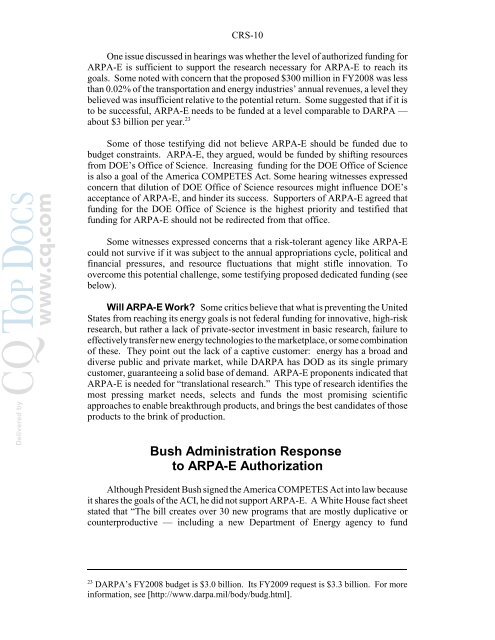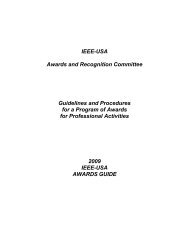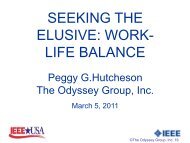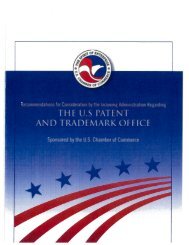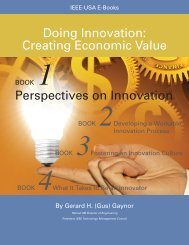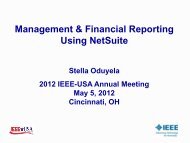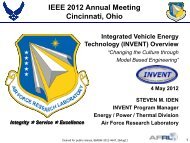Advanced Research Projects Agency - Energy (ARPA-E ... - IEEE-USA
Advanced Research Projects Agency - Energy (ARPA-E ... - IEEE-USA
Advanced Research Projects Agency - Energy (ARPA-E ... - IEEE-USA
You also want an ePaper? Increase the reach of your titles
YUMPU automatically turns print PDFs into web optimized ePapers that Google loves.
CRS-10<br />
One issue discussed in hearings was whether the level of authorized funding for<br />
<strong>ARPA</strong>-E is sufficient to support the research necessary for <strong>ARPA</strong>-E to reach its<br />
goals. Some noted with concern that the proposed $300 million in FY2008 was less<br />
than 0.02% of the transportation and energy industries’ annual revenues, a level they<br />
believed was insufficient relative to the potential return. Some suggested that if it is<br />
to be successful, <strong>ARPA</strong>-E needs to be funded at a level comparable to D<strong>ARPA</strong> —<br />
about $3 billion per year. 23<br />
TOP DOCS<br />
www.cq.com<br />
Delivered by<br />
CQ<br />
Some of those testifying did not believe <strong>ARPA</strong>-E should be funded due to<br />
budget constraints. <strong>ARPA</strong>-E, they argued, would be funded by shifting resources<br />
from DOE’s Office of Science. Increasing funding for the DOE Office of Science<br />
is also a goal of the America COMPETES Act. Some hearing witnesses expressed<br />
concern that dilution of DOE Office of Science resources might influence DOE’s<br />
acceptance of <strong>ARPA</strong>-E, and hinder its success. Supporters of <strong>ARPA</strong>-E agreed that<br />
funding for the DOE Office of Science is the highest priority and testified that<br />
funding for <strong>ARPA</strong>-E should not be redirected from that office.<br />
Some witnesses expressed concerns that a risk-tolerant agency like <strong>ARPA</strong>-E<br />
could not survive if it was subject to the annual appropriations cycle, political and<br />
financial pressures, and resource fluctuations that might stifle innovation. To<br />
overcome this potential challenge, some testifying proposed dedicated funding (see<br />
below).<br />
Will <strong>ARPA</strong>-E Work? Some critics believe that what is preventing the United<br />
States from reaching its energy goals is not federal funding for innovative, high-risk<br />
research, but rather a lack of private-sector investment in basic research, failure to<br />
effectively transfer new energy technologies to the marketplace, or some combination<br />
of these. They point out the lack of a captive customer: energy has a broad and<br />
diverse public and private market, while D<strong>ARPA</strong> has DOD as its single primary<br />
customer, guaranteeing a solid base of demand. <strong>ARPA</strong>-E proponents indicated that<br />
<strong>ARPA</strong>-E is needed for “translational research.” This type of research identifies the<br />
most pressing market needs, selects and funds the most promising scientific<br />
approaches to enable breakthrough products, and brings the best candidates of those<br />
products to the brink of production.<br />
Bush Administration Response<br />
to <strong>ARPA</strong>-E Authorization<br />
Although President Bush signed the America COMPETES Act into law because<br />
it shares the goals of the ACI, he did not support <strong>ARPA</strong>-E. A White House fact sheet<br />
stated that “The bill creates over 30 new programs that are mostly duplicative or<br />
counterproductive — including a new Department of <strong>Energy</strong> agency to fund<br />
23<br />
D<strong>ARPA</strong>’s FY2008 budget is $3.0 billion. Its FY2009 request is $3.3 billion. For more<br />
information, see [http://www.darpa.mil/body/budg.html].


